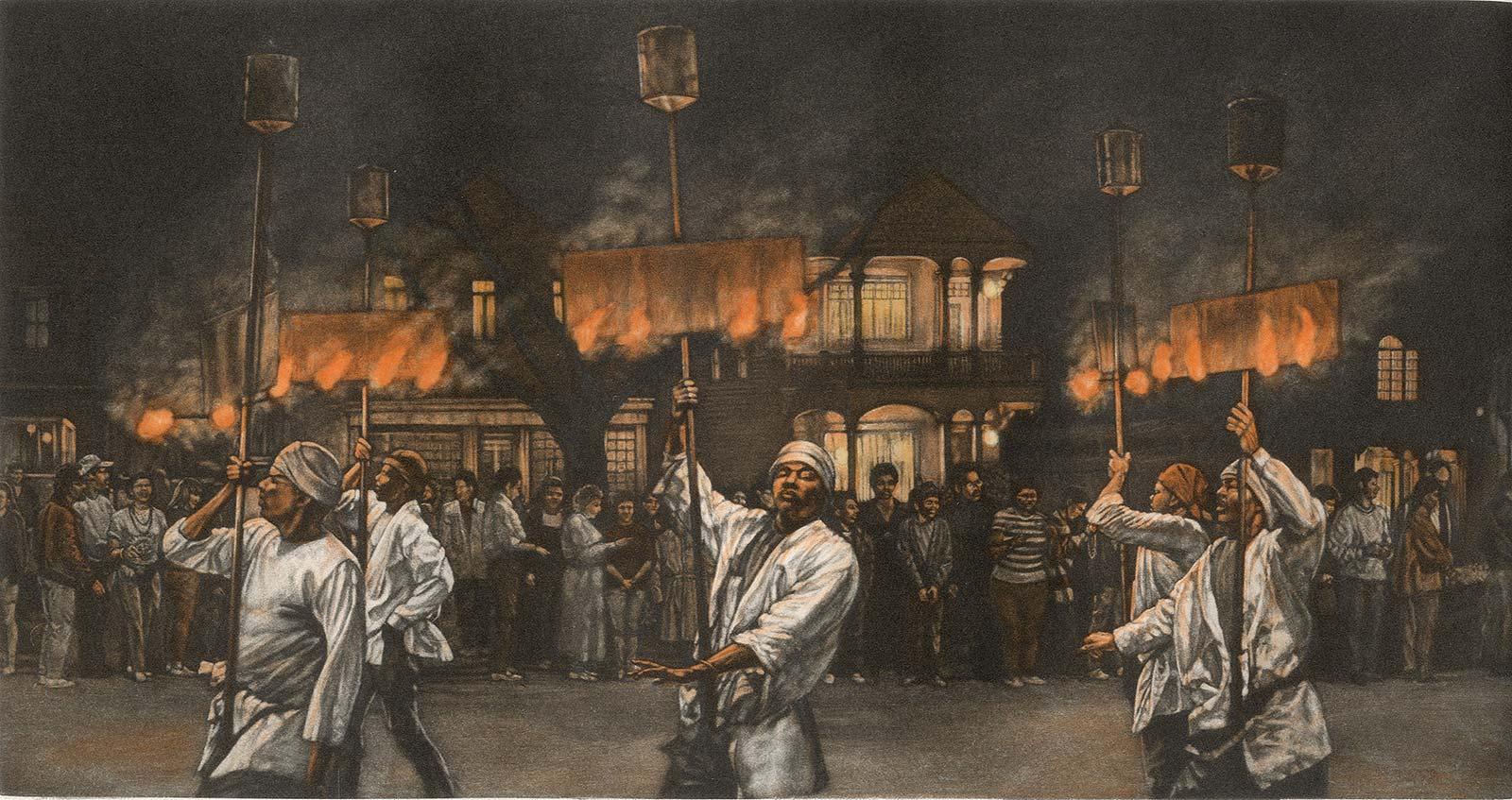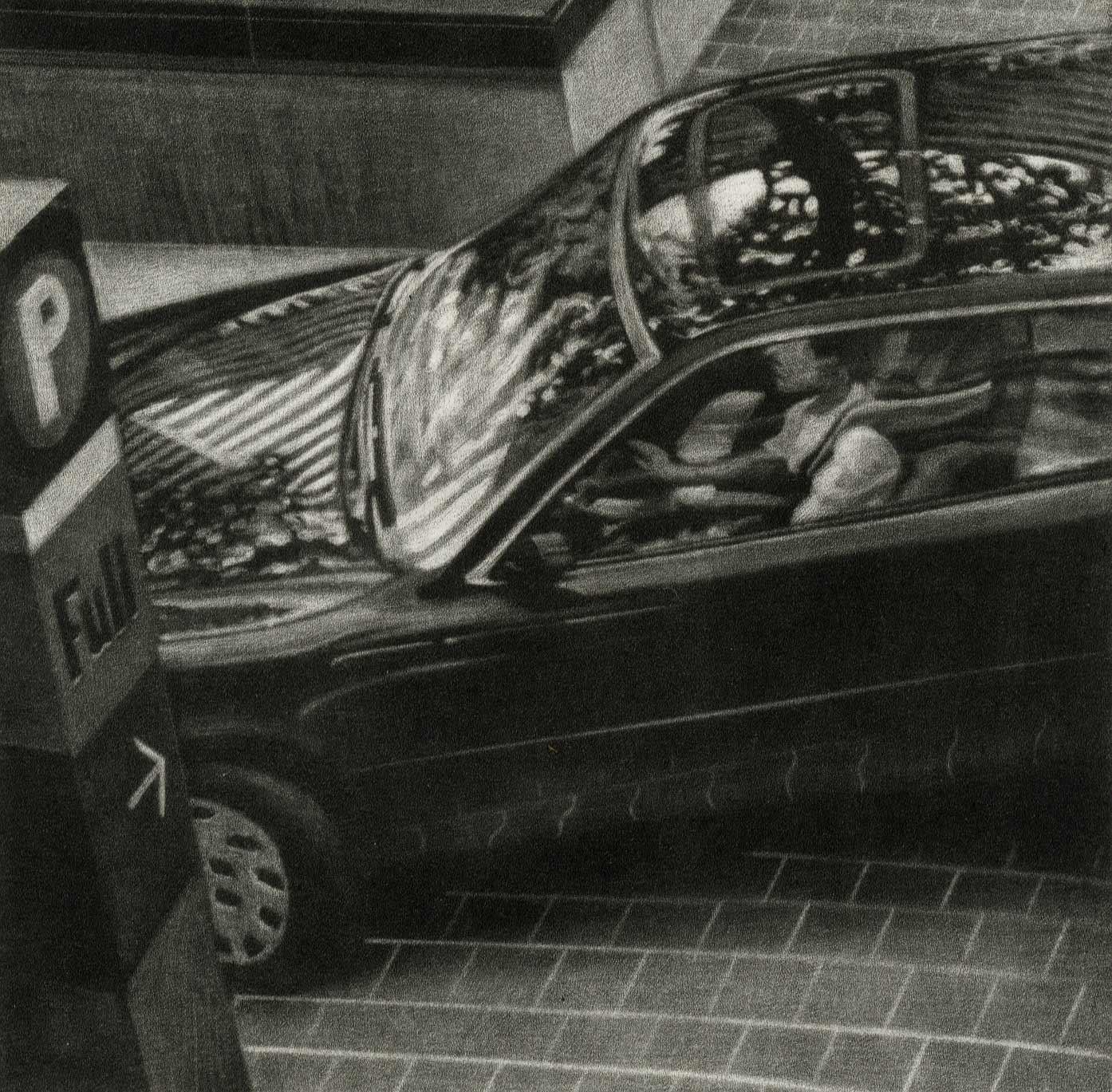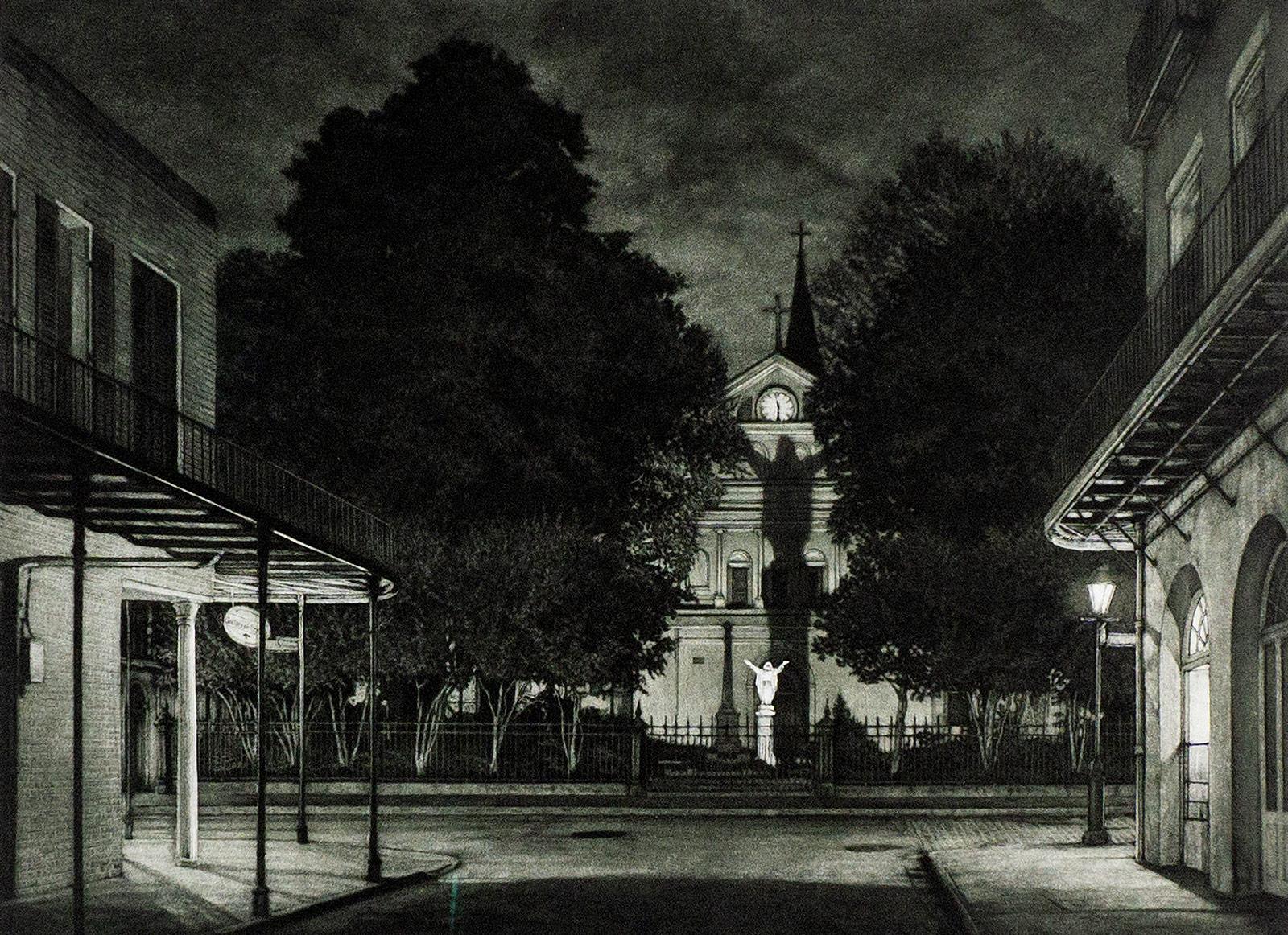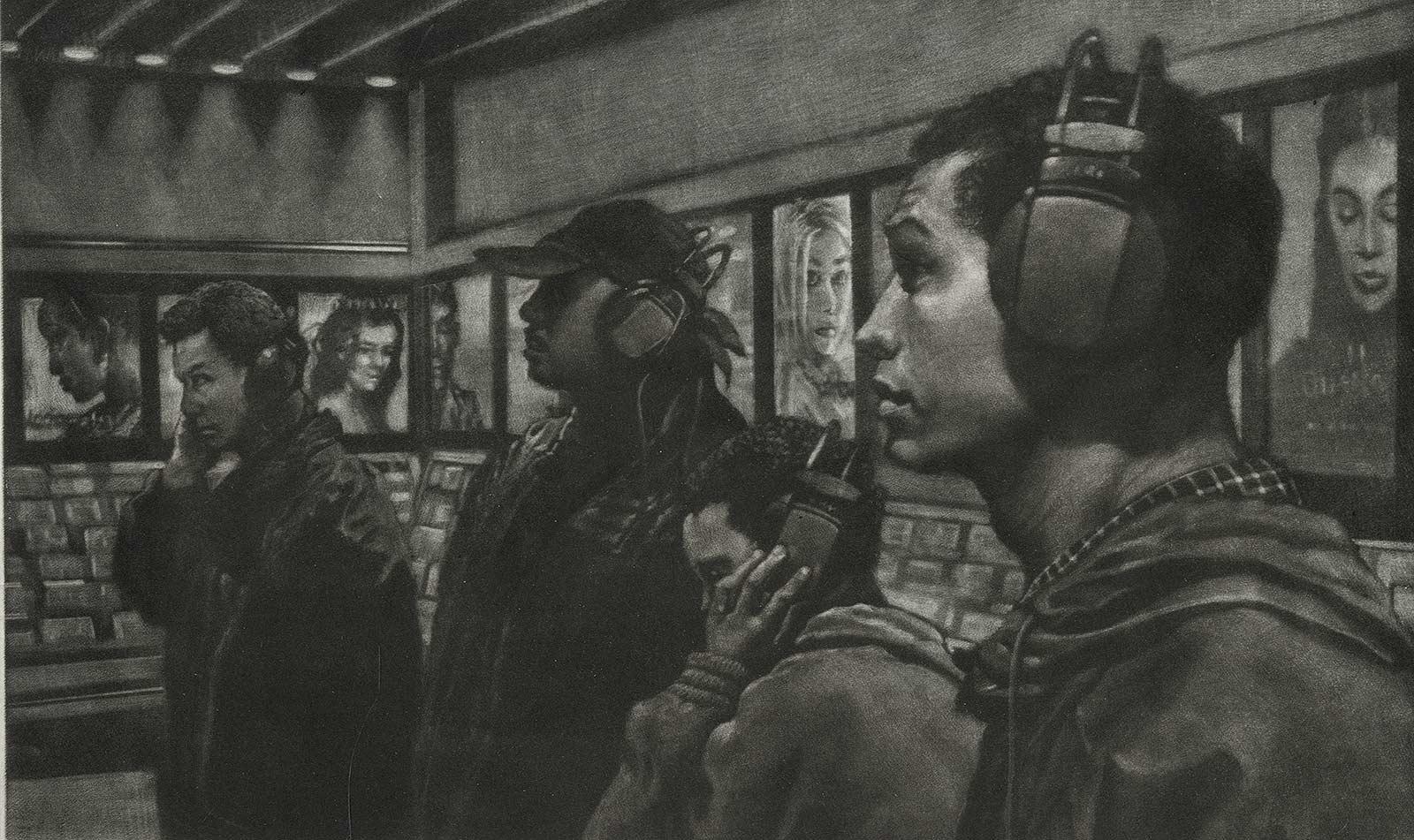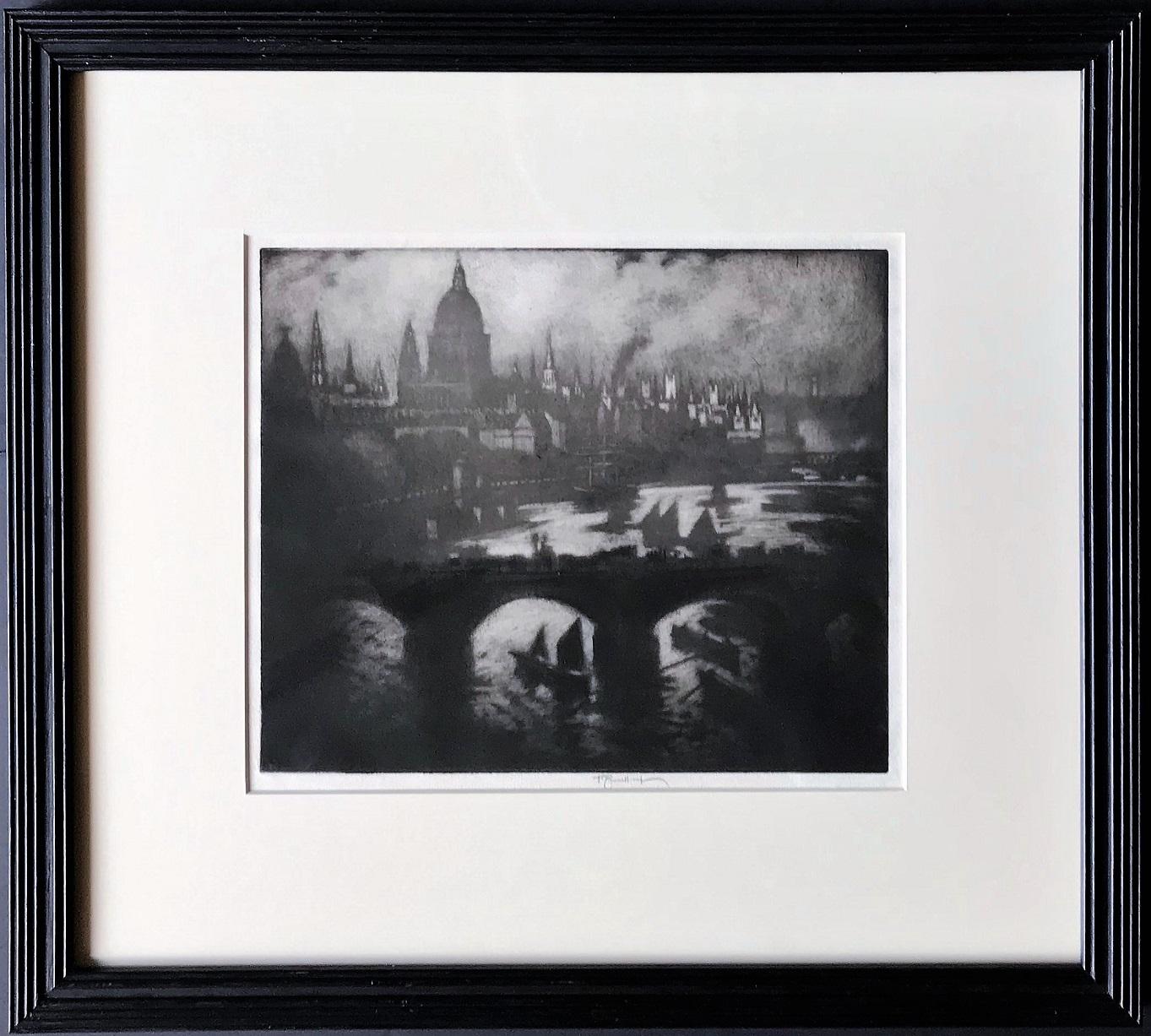Frederick MershimerInto the Night (a lone male emerges from a subway stop by the Flatiron Building)2006
2006
About the Item
- Creator:Frederick Mershimer (1958, American)
- Creation Year:2006
- Dimensions:Height: 6.88 in (17.48 cm)Width: 4.25 in (10.8 cm)
- Medium:
- Movement & Style:
- Period:
- Condition:
- Gallery Location:New Orleans, LA
- Reference Number:1stDibs: LU84139780222
Frederick Mershimer
Frederick Mershimer received a BFA from Carnegie Mellon University, where he majored in painting and drawing. After moving to New York in 1983, he studied printmaking at the New School, Pratt Graphics Center (1984–87) and Manhattan Graphics Center (1988–92). Mershimer was initially drawn to the mezzotint process because it echoed his approach to drawing. In 2007, Stone and Press published a catalog raisonné of his work, titled Frederick Mershimer Mezzotints 1984–2006. Mershimer’s works are included in the collections of the Brooklyn Museum, the Cleveland Museum, the Corcoran Museum, the Fogg Art Museum, Georgetown University, Library of Congress, the McNay Art Museum, New Orleans Museum of Art, National Museum of American Art and the Whitney Museum.
- ShippingRetrieving quote...Ships From: New Orleans, LA
- Return PolicyA return for this item may be initiated within 14 days of delivery.
- 7 A. M. St. LouisBy Art WergerLocated in New Orleans, LAIt's early morning I'm St. Louis in this 2002 mezzotint that is signed and numbered Art Werger’s lyrical suburban scenes are evocative of boyhood summer evenings while his city imag...Category
21st Century and Contemporary American Modern Figurative Prints
MaterialsMezzotint
- Sanctuary (St. Anthony's Garden at rear of St. Louis Cathedral on Royal Street)By Frederick MershimerLocated in New Orleans, LAThis French Quarter garden is a serene haven with a lighted statue of Christ that exists not very far from the raucous revelry of New Orleans' Bourbon S...Category
1990s American Modern Landscape Prints
MaterialsAquatint, Mezzotint
- ListeningBy Art WergerLocated in New Orleans, LAListening is a 2000 mezzotint that is signed by the artist. Art Werger’s lyrical suburban scenes are evocative of boyhood summer evenings while his city images are fraught with tens...Category
21st Century and Contemporary American Modern Figurative Prints
MaterialsMezzotint
- Delayed (suburban New Jersey commuter walks thru rain because bus is late)By Art WergerLocated in New Orleans, LA"Delayed" is an edition of 100. Art Werger creates a memory of his boyhood home in suburban New Jersey. It's late, cold and rainy as this woman raises her umbrella to brave the wal...Category
21st Century and Contemporary American Modern Figurative Prints
MaterialsMezzotint
- Fire Dance (Flambeaux carriers light the path of Endymion parade in New Orleans)By Frederick MershimerLocated in New Orleans, LAThis impression is #109 Mershimer created a color mezzotint of the Mardi Gras scene in mid-city New Orleans. The parade was the Endymion crew marching on Canal Street near Jefferson ...Category
1990s American Modern Landscape Prints
MaterialsMezzotint
- Trent et UnBy Anne DykmansLocated in New Orleans, LAA miniature image in an edition of 30 features two beach huts and magical flying fish going by. The image is surreal and serene both at the same time, A lot of quiet emotion is comm...Category
1990s Modern Landscape Prints
MaterialsMezzotint
- Wren's CityBy Joseph PennellLocated in Storrs, CTWren's City. 1909. Mezzotint. Wuerth 504. 10 x 11 7/8 (sheet 12 3/8 x 14 3/8). Printed on laid wove paper. A rich impression printed by the artist. Signed and annotated 'imp' in penc...Category
Early 1900s American Modern Landscape Prints
MaterialsMezzotint
- Palazzo dell'AngeloBy John Taylor ArmsLocated in Middletown, NYPalazzo dell'Angelo 1931 Etching and drypoint on cream-colored, handmade laid paper with deckle edges, 7 1/4 x 6 3/4 inches (185 x 171 mm), edition of 100, full margins. Signed, dated and numbered "Ed. 100" in pencil, lower margin, second state (of three). Printed by Henry Carling, New York. Extremely minor mat tone and some inky residue in the top right corner, all unobtrusive and well outside of image area. An exquisite impression of this intricate image, with astonishing detail, and all the fine lines printing clearly. The image represents the first print which Arms printed on his own handmade paper. Framed handsomely with archival materials and museum grade glass in a wood gilt frame with a flower and garland motif. Illustrated: Dorothy Noyes Arms, Hill Towns and Cities of Northern Italy, p. 180; Anderson, American Etchers Abroad 1880-1930; Eric Denker, Reflections & Undercurrents: Ernest Roth and Printmaking in Venice, 1900-1940, p. 116. [Fletcher 233] Born in 1887 in Washington DC, John Taylor Arms studied at Princeton University, and ultimately earned a degree in architecture at the Massachusetts Institute of Technology in 1912. With the outbreak of W.W.I, Arms served as an officer in the United States Navy, and it was during this time that he turned his focus to printmaking, having published his first etching in 1919. His first subjects were the Brooklyn Bridge, near the Navy Yard, and it was during his wartime travel that Arms created a series of extraordinarily detailed etchings based on Gothic cathedrals and churches he visited in France and Italy. He used what was available to him, namely sewing needles and a magnifying glass, to create the incredibly rich and fine detail that his etchings are known for. Upon his return to New York after the war, Arms enjoyed a successful career as a graphic artist, created a series of etchings of American cities, and published Handbook of Print Making and Print Makers (Macmillan, 1934). He served as President of the Society of American Graphic Artists, and in 1933, was made a full member of the National Academy of Design. In its most modern incarnation, Palazzo dell'Angelo was constructed in or around 1570. The building, which has a rich and storied history, was erected upon the ruins of an earlier structure which predates the Gothic period. Some remnants of the earliest features of the residence were most certainly still visible when Arms visited, as they are today. Having a background in architecture, there's no question that Arms was moved by the beauty, history and ingenuity represented in the physical structure. One thing specifically gives away Arms's passion for the architecture, and that is the fact that he focused on the building's Moorish entranceway, balustrade, and two mullioned windows, and not on the curious Gothic era bas-relief of an angel nestled into the facade of the building, after which the structure is named. The sculpture itself doesn't appear in Arms's composition at all, despite the fact that it is the feature of the building that is most famous in its folklore. Arms instead focuses on the oldest portion of the architecture, even documenting some of the remnants of a fresco, and a funerary stele for the freedman Tito Mestrio Logismo, and his wife Mestria Sperata (visible above the water level, to the left of the door, behind the gondola), which was first described in 1436. Among the many notable bits of history regarding the Palazzo, it has been documented that Tintoretto painted frescos of battle scenes on the facade of the building. The paintings have been lost to time and the elements, but not entirely to history. The empty frame...Category
1930s American Modern Figurative Prints
MaterialsEtching, Drypoint
- Werner Drewes, 125th Street at Broadway, NYCBy Werner DrewesLocated in New York, NYWerner Drewes brought his modernist vision to this subject but created, in my opinion, a great work of the Etching Revival. The reference is Rose 183. It...Category
1930s American Modern Landscape Prints
MaterialsDrypoint
- 'Jones Island' original woodcut engraving by Gerrit SinclairBy Gerrit SinclairLocated in Milwaukee, WIThe print 'Jones Island' is something of a self portrait. In the image, an artist stands before and easel, depicting the docks and buildings on the coast. The title indicates that this is Jones Island in Milwaukee, the peninsula along Lake Michigan that today is home to largely industrial buildings. The buildings and figures in the print suggest that this might be a view of the last of the Kashubian or German immigrant settlements on the peninsula before they were evicted in the 1940s to make way for the development of the harbor. The artist in the image thus acts as a documentarian of these peoples. The careful line-work of the woodblock engraving adds a sense of expressionism to the scene, leaving the figures and buildings looking distraught and dirty, though the image nonetheless falls into the Social Realist category that dominated American artists during the Great Depression. This print was published in 1936 as part of the Wisconsin Artists' Calendar for the year 1937, which included 52 original, hand-made prints – one for each week of the year. 6 x 5 inches, image 10 x 7.13 inches, sheet 13.43 x 12.43 inches, frame Signed "GS" in the print block,upper left Entitled "Jones Island" lower left (covered by matting) Inscribed "Wood Engraving" lower center (covered by matting) Artist name "Gerrit V. Sinclair" lower right (covered by matting) Framed to conservation standards using 100 percent rag matting and museum glass, all housed in a silver gilded moulding. Gerrit Sinclair studied at the Art Institute of Chicago from 1910 - 1915, under Vanderpoel, Norton, and Walcott. In World War I, he served in the Army Ambulance Corps and later recorded his experiences in a series of oil paintings. He taught in Minneapolis before arriving in Milwaukee in 1920 to become a member of the original faculty of the Layton School of Art. He was also a member of the Wisconsin Painters & Sculptors. Sinclair's paintings and drawings were executed in a lyrical, representational style, usually expressing a mood rather than a narrative. His paintings reveal a great sensitivity for color and atmosphere. His subject matter focused on cityscapes, industrial valleys, and working-class neighborhoods, captured from eye-level. A decade before the popularity of Regionalism, Sinclair's strong interest in the community was reflected not only in his paintings, but also in his encouragement to students to return to their communities as artists and teachers. Joseph Friebert...Category
1930s American Modern Figurative Prints
MaterialsWoodcut, Engraving
- Irving Guyer, Christmas Trees on Second Street (NYC)By Irving GuyerLocated in New York, NYPhiladelphia-born Irving Guyer attended the Art Students League and worked in New York City before moving to California. This print is signed and titled i...Category
1930s American Modern Figurative Prints
MaterialsEtching, Drypoint
- Under the BridgeBy Lawrence WilburLocated in Storrs, CTUnder the Bridge. 1985. Etching and drypoint. 9 1/2 x 12 1/8 (sheet 20 1/16 x 22). Edition 27, #13. Printed on cream wove paper, on the full sheet with deckle edges. A rich impression in excellent condition, housed in an archival folder. The etching has never been matted. Titled and numbered in pencil. by the artist; signed and initialed in pencil by the artist's estate. Provenance: the artist's estate A dramatic view of the lower East Side in New York. Housed in an archival folder awaiting your choice of mat and frame. Painter and printmaker Lawrence Nelson Wilbur...Category
20th Century American Modern Figurative Prints
MaterialsDrypoint, Etching
